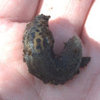Black/Red Beetle on corn stalk. What is it?
StephanieHS
9 years ago
Related Stories

SUMMER FRUITS AND VEGETABLESHow to Grow Your Own Fresh, Sweet Corn
Here's how to plant and care for your own mini cornfield
Full Story
GARDENING GUIDESBackyard Birds: Northern Cardinals in the Snow, and Other Red Birds
Brilliant crimson feathers make these friends stand out in a crowd
Full Story
FALL AND THANKSGIVINGIt's Black and White and Fall All Over in a Holiday-Happy Home
Get inspired for budget-friendly fall decorating by a resourceful stylist's thrifty but sophisticated adornments
Full Story
FLOWERSRudbeckia Mania: Go Beyond Black-Eyed Susan in the Garden
Branch out from typical nursery fare, with lesser-known Rudbeckia species that have delightfully unexpected features
Full Story
EDIBLE GARDENSSummer Crop: How to Grow Blueberries
Plant blueberries in spring or fall for garden beauty through three seasons — and a sweet superfood in summer
Full Story
HOUSEPLANTSHow to Force Amaryllis Bulbs Indoors
Enjoy vibrant red blossoms even as gardens turn snowy white, by teaching this hardy repeat performer to ignore the calendar
Full Story
GARDENING GUIDES6 Plants That Beat Butterfly Bush for the Wildlife Draw
It's invasive, a nonnative and a poor insect magnet. Check out these better alternatives to butterfly bush in the garden
Full Story
GARDENING GUIDESBackyard Birds: How to Care for American Goldfinches
The American goldfinch is a bright-in-the-summer visitor and one of the only vegetarian songbirds. Here's how to give them a healthy habitat
Full Story
EDIBLE GARDENSSummer Crops: How to Grow Tomatoes
Plant tomato seedlings in spring for one of the best tastes of summer, fresh from your backyard
Full Story
COOL-SEASON CROPSCool-Season Vegetables: How to Grow Radishes
Fast growing and bright, these easy-care veggies are great for kids and bring plentiful color to a fall or spring garden
Full Story







rhizo_1 (North AL) zone 7
ken_adrian Adrian MI cold Z5
Related Professionals
Norton Shores Landscape Architects & Landscape Designers · San Juan Landscape Architects & Landscape Designers · Finneytown Landscape Architects & Landscape Designers · Williamsburg Landscape Contractors · Corona Landscape Contractors · Dixon Landscape Contractors · Flagstaff Landscape Contractors · Fruit Heights Landscape Contractors · Lorain Landscape Contractors · Red Oak Landscape Contractors · Roseville Landscape Contractors · Spring Landscape Contractors · Uxbridge Landscape Contractors · Wayland Landscape Contractors · Shafter Landscape Contractorsrhizo_1 (North AL) zone 7
StephanieHSOriginal Author
StephanieHSOriginal Author
rhizo_1 (North AL) zone 7
StephanieHSOriginal Author
rhizo_1 (North AL) zone 7
StephanieHSOriginal Author
rhizo_1 (North AL) zone 7
rhizo_1 (North AL) zone 7
StephanieHSOriginal Author